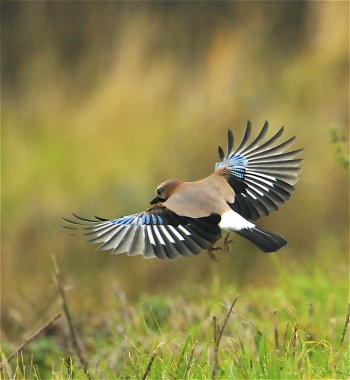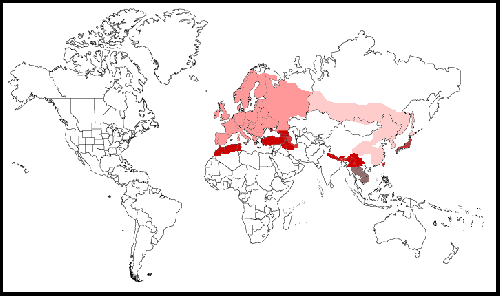- Garrulus glandarius
Identification
32 - 36cm (12½-14¼ in). A distinctive woodland corvid.
- Mainly pinkish-brown plumage
- Black moustachial stripe
- Blue, black and white panels on wings
- Black tail
- White uppertail and undertail-coverts (well visible in flight)
- Broad wings resulting in a peculiar jerky flapping flight
- Nominate group with whitish throat and whitish crown with black streaks
Variations
- fasciatus has a domed head
- cervicalis group birds with white cheeks and black crown, also greyer plumage
- atricapillus group with white forehead, black crown and white cheeks
- hyrcanus group similar to nominate but blacker crown
- brandtii group has darker plumage, brown-whitish throat and brownish crown with black streaks
- japonicus group with black lores, connected with broader black moustachial stripe
- bispecularis group with unstreaked brown crown and whitish brown throat
- leucotis group similar to atricapillus
Sexes similar. Juveniles are darker reddish-brown.
Distribution
Occurs in most of Europe, North Africa, the Middle East, Siberia, China, Japan, the Himalayas and Indochina.
Mainly resident but occasionally irruptive in far north of range and can result in birds of northern subspecies occurring in winter.
| Legend • nominate group |
Taxonomy

Photo © by scottishdude
Lesvos, 27 April 2010

Photo © by Alok Tewari
Forest-edge, Dist. Almora, Uttarakhand Himalayas, Alt. 6500 ft., India, 17 October 2018
Subspecies

Photo © by Mark Bruce
Hsitou Forest, Nantou County, Taiwan, 26 December 2008
More than 30 subspecies of this bird have been described with about 20 from the Western Palearctic. These fall into several groups with the nominate group found over most of Europe[1],[3].
- Nominate group:
- G. g. rufitergum: Southern Scotland, England, Wales and northern France
- G. g. hibernicus: Ireland
- G. g. glandarius: Northern and central Europe
- G. g. severtzowi: Scandinavia and western Russia (sometimes merged into glandarius)
- G. g. lusitanicus: Northern Portugal and northern Spain (sometimes merged into fasciatus)
- G. g. fasciatus: Southern, central and eastern Spain
- G. g. corsicanus: Corsica
- G. g. albipectus: Italy, Dalmatian coast, Albania and Ionian Islands
- G. g. jordansi: Sicily (sometimes merged in albipectus)
- G. g. ichnusae: Sardinia
- G. g. graecus: Kosovo and southern Serbia, southern Bulgaria and Greece
- G. g. cretorum: Crete
- G. g. glaszneri: Cyprus
- G. g. ferdinandi: South-eastern Bulgaria to northern Turkey (Istranca Mountains)
- cervicalis group - Black-crowned Jay:
- atricapillus group - Black-capped Jay
- G. g. atricapillus: Lebanon to southern Syria, Israel and western Jordan
- G. g. anatoliae: Western Turkey and eastern Aegean Sea to western Asia Minor, northern Iraq and south-western Iran
- G. g. samios: Samos and Ikaria region of eastern Aegean Sea (Greece)
- G. g. iphigenia: Crimean Peninsula
- G. g. krynicki: Caucasus, Transcaucasia and northern Asia Minor
- hyrcanus group - Iranian Jay
- G. g. hyrcanus: Northern Iran (Elzburg Mountains and south shore of Caspian Sea)
- brandtii group - Brandt's Jay
- G. g. brandtii: Ural Mountains to Siberia, Lake Baikal and Altai and Sayan mountains
- G. g. bambergi: Mongolia to Sakhalin, southern Kuril Islands, Hokkaido and Korea (sometimes merged with brandtii)
- G. g. kansuensis: Kazakhstan (eastern Tien Shan) and western China (Gansu)
- G. g. pekingensis: Northern China (Liaoning) and south-western Manchuria
- japonicus group - Japanese Jay
- bispecularis group - Himalayan Jay or Red-crowned Jay
- G. g.s sinensis: Western China to northern Yunnan and north-eastern Myanmar
- G. g. taivanus: Taiwan
- G. g. persaturatus: Northern India (Khasi Hills of Assam) (sometimes merged with bispecularis)
- G. g. bispecularis: Himalayas (Kashmir to Nepal)
- G. g. interstinctus: Eastern Himalayas and south-eastern Tibet
- G. g. haringtoni: Myanmar (Mount Victoria in south Chin Hills)
- leucotis group - White-faced Jay
DNA reserach has shown only minor differences of small significance.
Habitat
Mainly deciduous woodland and forest, and oak in particular. Also in mixed forest, orchards, town parks and large gardens, and coniferous forest in the north and east of the Region.
Behaviour

Photo © by robby thai
Doi Phu Hom Pok NP, Thailand, 20 December 2017
Usually a very shy and wary bird, keeping in dense foliage. However, in city parks birds can become very confiding. Normally solitary or in family groups.
Diet
An omnivorous feeder. The diet includes invertebrates (notably caterpillars and beetles) but also eggs and nestlings and a wide variety of seeds and berries. Does visit garden bird tables where unmolested.
Breeding
Breeding starts in April in most of Europe. A pair stays together several years, possibly even lifelong. The nest is built by both sexes. It's a platfrom of twigs, placed some 4 to 6m above the ground, usually well concealed by foliage and near the tree centre. Lays 3 - 10 eggs (chiefly 5 - 7) which are incubated 16 - 17 days by the female. The nestling period is 19 - 23 days.
Vocalisation
The alarm call is a harsh, rasping screech. It is a great mimic.
Gallery
Click on photo for larger image
Subspecies G. g. japonicus, Japanese Jay
Photo © by Joseph Morlan
Karuizawa--Shiotsubo Hot Spring Hotel, Nagano Prefecture, Japan, 16 February 2019Subspecies G.g rufitergum, Juvenile
Photo © by
Sue and Simon Wakely
Whitford, Devon, May 2019Adult with juvenile, Subspecies fasciatus
Photo © by
max1
Ponte de Lima, Portugal, June 2019
References
- Clements, J. F., T. S. Schulenberg, M. J. Iliff, D. Roberson, T. A. Fredericks, B. L. Sullivan, and C. L. Wood. 2018. The eBird/Clements checklist of birds of the world: v2018. Downloaded from http://www.birds.cornell.edu/clementschecklist/download/
- BirdForum Member observations
- Del Hoyo, J, A Elliott, and D Christie, eds. 2009. Handbook of the Birds of the World. Volume 14: Bush-shrikes to Old World Sparrows. Barcelona: Lynx Edicions. ISBN 978-8496553507
- Madge, S. & Burn, H. (1994) Crows and Jays: A Guide to the Crows, Jays and Magpies of the World. Houghton Mifflin, Boston.
- Madge, S., Christie, D.A. & Kirwan, G.M. (2019). Eurasian Jay (Garrulus glandarius). In: del Hoyo, J., Elliott, A., Sargatal, J., Christie, D.A. & de Juana, E. (eds.). Handbook of the Birds of the World Alive. Lynx Edicions, Barcelona. (retrieved from https://www.hbw.com/node/60727 on 26 April 2019).
Recommended Citation
- BirdForum Opus contributors. (2024) Eurasian Jay. In: BirdForum, the forum for wild birds and birding. Retrieved 19 April 2024 from https://www.birdforum.net/opus/Eurasian_Jay
External Links
GSearch checked for 2020 platform.1










